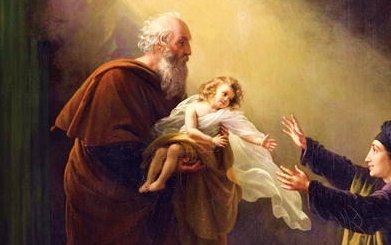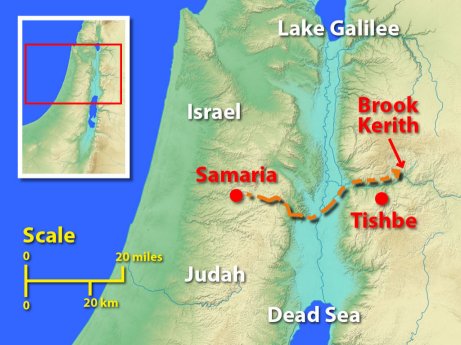
Elijah (Heb. Eliyahu or Eliyah) was a 9th century BC navi (prophet) of Israel. His name literally means 'Yah[weh] is El[ohim] (God)'. Apart from the reference to Elijah in 1 Kings 17:1 as "the Tishbite", who was one of the inhabitants of Gilead (trans-Jordan), no information about his background is available. Even this reference is obscure. The Masoretic Text suggests that while Elijah resided in Gilead (mittoshabe gile'ad) his birthplace was elsewhere (perhaps Tishbe of Naphtali). The Septuagint (LXX) reads es thesbón tés galaad, thus indicating Tishbe of Gilead. Josephus seems to concur (Antiquities 8.13.2). This has traditionally been identified with a site about 13 km north of the River Jabbok.

Elijah's prophetic ministry is recorded in 1 Kings 17-19; 21 and 2 Kings 1-2. These narratives are written in the purest classical Hebrew "of a type which can hardly be later than the 8th century" BC (W.F.Albright, From the Stone Age to Christianity, p.307). They could not have enjoyed an existence for long in oral form. They describe his ministry to the northern kingdom during the Omrid Dynasty. Elijah was contemporary with Ahab and Ahaziah, and from the position of the translation narrative (2 Ki.2) and the answer to Jehoshaphat's question in 2 Kings 3:11, we conclude that his translation to Heaven probably occurred about the time of the accession to the throne of Jehoram of Israel.
The difficulty presented to this conclusion by 2 Chronicles 21:12-15 can possibly be resolved either by interpreting the much controverted 2 Kings 8:16 to teach a co-regency of Jehoshaphat and Jehoram, kings of Judah, or by regarding the letter as a prophetic oracle written prior to his translation.
The Elijah Cycles presents six episodes in the life of the navi (prophet):
- 1. His prediction of drout and his subsequent flight;
- 2. The Mt.Carmel Contest;
- 3. The flight to Horeb;
- 4. The Naboth incident;
- 5. The oracle about Ahaziah; and
- 6. His translation to Heaven.
Except for the last, they are all basically concerned with the clash between the worship of Yahweh and Ba'al. The Ba'al in these stories is Ba'al-Melqart, the official protective deity of Tyre. Ahab fostered this Phoenician variant of the nature-religion of Canaan after his marriage with the Tyrian princess, Jezebel (1 Ki.16:30-33), but it was Jezebel who was chiefly responsible for the systematic extermination of Yahweh worship and the propagation of the Ba'al cult in Israel (1 Ki.18:4,13,19; 19:10,14).
1. Elijah appears in the first episode (1 Ki.17) without introduction, and after the delivery of the oracle to Ahab announcing a drout he retires beyond Ahab's jurisdiction first to the wadi (brook) Cherith on the east of Jordan (see map above) and then to Zarephath (modern Sarafend below Sidon still preserves the name and and overlooks what remains of this ancient Mediterranean sea-port). Elijah was miraculously sustained in both places, and while at Zarephath he performed a miracle of healing (1 Ki.17:17-24).
2. The second episode, three years later (1 Ki.18:1; cp. Lk.4:25; Jas.5:17 which follow Jewish tradition), recounts the break in the drout following the overthrow of organised Ba'al worship on Mt. Carmel. The drout imposed and withdrawn at Yahweh's davar (word) was a challenge to Ba'al's sovereignty over nature. 1 Kings 17 had depicted Elijah in the very stronghold of Ba'al-Melqart, sustained by Yahweh, while the country languishes (1 Ki.17:12; cp. Josephus, Antiquities 8.13.2). 1 Kings 18 brings the challenge into the open, and Yahweh's supremacy is spectacularly demonstrated. That Ba'al worship was certainly not wiped out at Mt.Carmel is seen from later references (e.g. 2 Ki.10:18-21).
3. The third episode (1 Ki.19) describing Elijah's flight to Horeb (Sinai, at Jabal al-Lawz in modern-day western Saudi Arabia) to avoid Jezebel's wrath is particularly significant. Horeb was the sacred mountain where the covenant Elohim (God) of Moses had made Himself known, and Elijah's return to this place represents the return of a loyal but disheartened navi (prophet) to the very source of the emunah (faith) for which he had contended. The closing commission in 1 Kings 19:15-18 seems to have only been partially discharged by Elijah. The accession of Hazael and Jehu to the thones of Syria and Israel respectively is recorded in the Elisha Cycle.
4. The Naboth incident (1 Ki.21) illustrates and vindicates the principle embedded in the religious consciousness of Israel, that land owned by an Israelite family or clan was understood as a gift from Yahweh, and that failure to recognise this and respect the rights of the individual and family within the covenant community would issue a mishpat (judgment). Elijah emerges as a champion of the strong ethical demands of the Covenant of Moses so significantly lacking in the Ba'al cult.
5. The fifth episode in 2 Kings 1 continues to illustrate the Yahweh-Ba'al clash. Ahaziah's dependence upon the life-god of Syria, Ba'al-zebub (Ba'al-zebul of Rash Shamra texts, cp. Mt.10:25 - Ba'al-zebub, meaning 'Lord of the Flies', was probably a way of ridiculing the Syrian deity). A judgment of fire also falls on those who endeavoured to resist the Davar (Word) of Yahweh by harming His navi (prophet) (2 Ki.1:9-15).
6. The translation of Elijah in a whirlwind (s'ará) brings to a dramatic close his spectacular prophetic career. The exclamation of Elisha (2 Ki.2:12), "Father, father! The chariots of Israel and its horsemen!" (NRSV) is repeated in 2 Kings 13:14 with reference to Elisha.
Two observations may be made about the importance of Elijah. First, he stands in the Tanakh (Old Testament) tradition of ecstatic prophecy coming through from the days of Samuel and he is also a forerunner of the 8th-century BC rhapsodists or writing nevi'im (prophets) (see the Prophecy, Revelation and Olive Branch pages). Messianic Evangelicals have stood in the rhapsodist tradition since their beginning and are increasingly moving into the ecstatic tradition as part of the "restoration of all things" (Ac.3:21) for the end-time Remnant work (see the 1619 Prophecy).
Elijah's link with with the earlier tradition is seen that he is first of all a man of action and his Ruach/Spirit-determined reactions defy human anticipation (1 Ki.18:12). In the background of the Elijah pericope the prophetic schools of Samuel's day continue to exist (1 Ki.18:4,13; 2 Ki.2:3,5,7). His link with the later nevi'im (prophets) lies in his constant endeavour to recall his people to the emunah (faith) of Moses, both in worshipping Yahweh alone as well as in proclaiming Torah standards of righteousness in the community. In both these respects he anticipates the more fully developed oracles of Amos and Hosea.
This advocacy of the emunah (faith) of Moses by Elijah is supported by several details which suggest a parallel between Elijah and Moses. Elijah's return to Horeb is obvious enough, but there is also the fact that Elijah is accompanied and succeeded by Elisha as Moses was by Joshua. The parallel is quite striking. Not only has the death of Moses an air of mystery attaching to it (Dt.34:6) but his successor secured the allegiance of Israel by participating in the same spirit as Moses and demonstrated his fitness for office by miraculous river crossing (Dt.34:9; Josh.4:14). The translation narrative (2 Ki.2) reproduces this tavnith (pattern) fairly precisely.
The fact also that Elohim (God) answers Elijah by fire on two occasions (1 Ki.18:38; 2 Ki.1:10,12) seems to look back to the exhibition of Elohim's (God's) presence and judgment in fire in the Exodus narratives (e.g. Ex.12:21; 19:18; 24:17; Num.11:1; 16:35). Little wonder that in Jewish Haggadic thought Elijah was viewed as a counterpart to Moses.
Second, his spirit and ministry is spoken of as being revived "before the coming of the great and dreadful day of Yahweh" (Mal.4:6.6, KJV). This theme is a popular one in the Jewish Mishnah and was a common topic of discussion during the ministry of Yah'shua (Jesus) (Mk.8:28). Yah'shua (Jesus) indicated that the Malachi prophecy had reference to the ministry of John the Baptist (Mt.11:14; 17:12ff.) but it is clear that it also points the very end time before the Second Coming when the full restoration of all the gifts and powers of the Ruach (Spirit) takes place for the equipping of the Remnant.
Elijah appears in person on the mount of transfiguration (Mk.9:4) and he is referred to elsewhere in the Messianic Scriptures (Lk.4:25-26; Rom.11:2-4; Jas.5:17-18).
(10 March 2018)
| 

